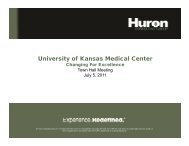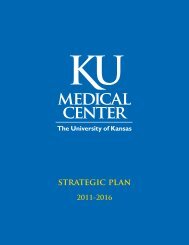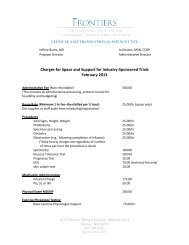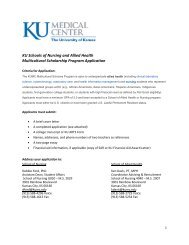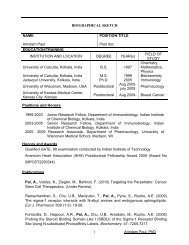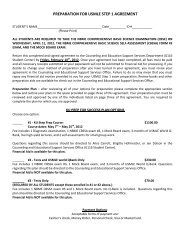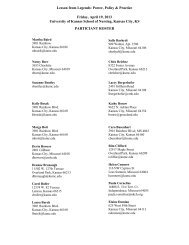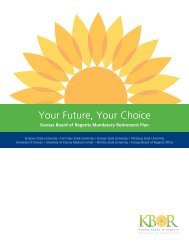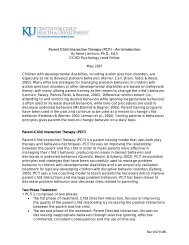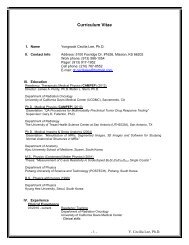Clinical Orientation Manual - University of Kansas Medical Center
Clinical Orientation Manual - University of Kansas Medical Center
Clinical Orientation Manual - University of Kansas Medical Center
You also want an ePaper? Increase the reach of your titles
YUMPU automatically turns print PDFs into web optimized ePapers that Google loves.
Title <strong>of</strong> Course:<br />
Pediatrics<br />
Course Director: Mitzi Scotten, MD, mscotten@kumc.edu, x8-6364, <strong>of</strong>fice: 4008 Miller Bldg.<br />
Course Coordinator: Debra Heisler, dheisler@kumc.edu, x8-6310, <strong>of</strong>fice: 4008 Miller Building.<br />
Your reigning 2013 Clerkship Coordinator <strong>of</strong> the Year, as voted on by your friendly SOM14 class.<br />
This Section Updated By: John Meyer, updated in 2013. So when I bust into first person<br />
narrative, you’ll know who I am...<br />
Critical Info Before You Read Any Further: YOU NEED TO HAVE YOUR BADGE WITH YOU<br />
AT ALL TIMES DURING THIS ROTATION. Stop what you are doing right now and go get it. You<br />
can’t get on any peds floor in the hospital without one - that includes the general peds unit,<br />
mother-baby, labor and delivery, the PICU, and the NICU. Any stranger <strong>of</strong>f the street can go hang<br />
out with adult patients, but our kids are locked down tight!<br />
Grading Breakdown: The Sup-HS-Sat breakdown is your basic 90/80/70 system. 35% <strong>of</strong> your<br />
grade is your adjusted Shelf score (the syllabus covers the adjustment). 15% is your oral exam<br />
grade. 50% is your evaluations. There are two extra credit opportunities when you are in the<br />
nursery and in the same-day sick clinic that involve presenting and leading a discussion on an<br />
evidence-based topic. It doesn’t involve too much work, and you get lunch <strong>of</strong> the deal - in other<br />
words, you’d be silly not to do it. The syllabus covers grading in detail, but just remember that to<br />
get a good grade in Peds, you have to study hard, show interest (or better yet, be interested), and<br />
work hard as part <strong>of</strong> the team taking care <strong>of</strong> your patients...you’ll notice that this formula for<br />
grading success works well in all <strong>of</strong> your rotations.<br />
Rotation Overview: Peds will be one <strong>of</strong> the most fun rotations you do all year. It’s busy in that<br />
you move quickly through a lot <strong>of</strong> different services, but that also lets you take care <strong>of</strong> kids in a lot<br />
<strong>of</strong> different settings. You spend three weeks covering inpatient services (the floor,<br />
PICU/NICU/Nights, and full-term nursery) and three weeks <strong>of</strong> outpatient care covering<br />
subspecialty clinics/consults, the same-day sick clinic, and a community peds clinic. There are<br />
also a number <strong>of</strong> PBL discussions and resident teaching conferences.<br />
The best thing you can do to prepare for the rotation is to have a kid yourself (and I’m only half<br />
joking). It’s a great rotation to learn how to examine kids <strong>of</strong> all ages and interact with patients and<br />
their families. And if you didn’t pay attention above, KEEP YOUR BADGE WITH YOU. Oh, and<br />
the peds clerkship feeds you lunch more than any other clerkship, which is nice.<br />
Dress Code: Ask your residents, but you can generally wear scrubs in the nursery, in ICUs, and<br />
covering the floor on nights or weekends. For the dudes, dress pr<strong>of</strong>essionally but remember that<br />
ties scare kids...and we don’t like to scare kids on this rotation. For the ladies, dress<br />
pr<strong>of</strong>essionally (and I am not qualified to tell you what that means). You can generally get by<br />
without the white coat on most services (those scare kids, too), but you might want to wear it on<br />
rounds.<br />
Hours: Outpatient clinics are usually 8:30 to 5 and you don’t work weekends. For inpatient<br />
services, plan on arriving around 6 or a little earlier to get checkout on your patients and then do<br />
your pre-rounds. On the inpatient side, you work 1 weekend day per week, during which you will<br />
round, write your notes, and then generally go home (but that’s up to your residents). You also<br />
get one weekday afternoon <strong>of</strong>f to study - you figure that out among your colleagues, and try not to<br />
be “that guy” and always take Friday afternoon <strong>of</strong>f (some services won’t allow that).<br />
26



